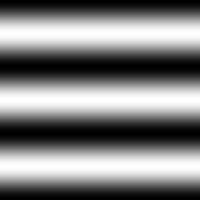Imagick::functionImage
(Não há informação de versão disponível, talvez apenas no SVN)
Imagick::functionImage — Applies a function on the image
Descrição
$function
, array $arguments
[, int $channel = Imagick::CHANNEL_DEFAULT
] )Applies an arithmetic, relational, or logical expression to a pseudo image.
See also » ImageMagick v6 Examples - Image Transformations — Function, Multi-Argument Evaluate
Este método está disponível se o PHP foi compilado com o ImageMagick versão 6.4.9 ou superior.
Parâmetros
-
function -
Refer to this list of function constants
-
arguments -
Array of arguments to pass to this function.
Valor Retornado
Retorna TRUE no sucesso.
Erros
Lança ImagickException em caso de erro.
Exemplos
Exemplo #1 Create a sinusoidal gradient
<?php
$imagick = new Imagick();
$imagick->newPseudoImage(200, 200, 'gradient:black-white');
$arguments = array(3, -90);
$imagick->functionImage(Imagick::FUNCTION_SINUSOID, $arguments);
header("Content-Type: image/png");
$imagick->setImageFormat("png");
echo $imagick->getImageBlob();
?>
O exemplo acima irá imprimir algo similar à:

Exemplo #2 Create a gradient from the polynomial (4x^2 - 4x + 1)
<?php
$imagick = new Imagick();
$imagick->newPseudoImage(200, 200, 'gradient:black-white');
$arguments = array(4, -4, 1);
$imagick->functionImage(Imagick::FUNCTION_POLYNOMIAL, $arguments);
header("Content-Type: image/png");
$imagick->setimageformat("png");
echo $imagick->getImageBlob();
?>
O exemplo acima irá imprimir algo similar à:

Exemplo #3 Create a complex gradient from the polynomial (4x^2 - 4x^2 + 1) modulated by a sinusoidal gradient
<?php
$imagick1 = new Imagick();
$imagick1->newPseudoImage(200, 200, 'gradient:black-white');
$arguments = array(9, -90);
$imagick1->functionImage(Imagick::FUNCTION_SINUSOID, $arguments);
$imagick2 = new Imagick();
$imagick2->newPseudoImage(200, 200, 'gradient:black-white');
$arguments = array(0.5, 0);
$imagick2->functionImage(Imagick::FUNCTION_SINUSOID, $arguments);
$imagick1->compositeimage($imagick2, Imagick::COMPOSITE_MULTIPLY, 0, 0);
header("Content-Type: image/png");
$imagick1->setImageFormat("png");
echo $imagick1->getImageBlob();
?>
O exemplo acima irá imprimir algo similar à:
